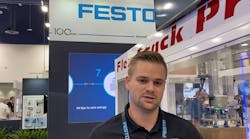Links for further reading on this topic from Automation World:
- https://www.automationworld.com/analytics/article/33013986/avevas-connected-interactive-strategy
- https://www.automationworld.com/factory/plant-maintenance/article/33014057/siemens-industrial-copilot-uses-ai-for-humanmachine-collaboration
- https://www.automationworld.com/analytics/article/33013507/ai-and-chatgpt-a-cool-idea-and-a-cautionary-tale
- https://www.automationworld.com/control/article/22366503/artificial-intelligence-autonomously-controls-jsr-chemical-plant
- https://www.automationworld.com/factory/plant-maintenance/article/33008262/siemens-and-microsoft-team-up-with-open-ai
TRANSCRIPT
Welcome to this Industry Update episode of the Automation World Gets Your Questions Answered podcast. I’m David Greenfield, editor in chief at Automation World. In case you missed the first one released earlier this fall, these Industry Updates are a new addition to this podcast series as a way to help keep our listeners updated on the latest goings on in the automation industry.
We are still featuring interviews with industry experts each month. These Industry Update episodes are being posted in addition to our regular interview episodes.
For this Industry Update, I want to share some insights into the latest news around the incorporation of AI into manufacturing operations software.
We’ve all heard lots about ChatGPT and other artificial intelligence large language models—about what they can do well, what they can’t do very well—at least not yet—and, of course, many of the intellectual property issues associated with it that seem to be growing more complex and litigious by the day.
Meanwhile, there’s quite a bit happening with these AI technologies in terms of how they’re being incorporated into the operations technology software the manufacturing industry uses every day.
For example, at the Aveva World event a couple of weeks ago, Aveva announced that it’s incorporating Microsoft Fabric, a data analytics technology, with Aveva Connect. Microsoft says Fabric has been developed to accelerate data analysis by developing AI models on a single foundation which means data doesn’t have to be moved to different sources for analysis. It’s also designed to help communicate the resulting AI insights by delivering them to workers via Microsoft 365 apps, such as Microsoft Excel and Microsoft Teams.
By combining Microsoft Fabric with Aveva Connect—Aveva’s collaborative platform that uses operations data to create digital twins for improved production and engineering, the companies are looking to streamline the process of collecting, transforming and unifying data from various plant floor and enterprise sources. By collecting data from different parts of a manufacturer’s operations, including manufacturing processes and supply chains, Aveva says it can better cleanse, transform and enrich data with relevant context to make it more useful for operations.
At Aveva World, Rob McGreevy, chief product officer, said: The technologies underlying Aveva Connect have been around for decades, but interconnectivity via the cloud to collect, capture, share and analyze data has really developed in just the past few years. He said Aveva is building on its experience to digitally design new capital assets and scan existing ones to bring them into this connected system for highly connected and interactive capabilities. Now, one of the subtle things about this shift, he said, is how it impacts interaction with a range of technologies—from enterprise systems like SAP to setting a control point on the plant floor.
Caspar Herzberg, CEO of Aveva, added that, in addition to Microsoft Fabric, several software packages from other companies will be on Connect by this time next year. And that includes technologies from analytics providers that compete with Aveva. He said Aveva’s plan is to have thousands of companies’ technologies on Connect.
Meanwhile, Siemens has been working with Microsoft around the use of OpenAI’s ChatGPT via a linkage between Siemens Teamcenter PLM software and Microsoft Teams. The resulting technology is Siemens Industrial Copilot, an AI-powered assistant designed to improve human-machine collaboration in manufacturing.
According to the companies, Siemens Industrial Copilot allows users to rapidly generate, optimize and debug complex automation code and shorten simulation times from weeks to minutes.
The Industrial Copilot ingests automation and process simulation information from Siemens Xcelerator and enhances it with Microsoft’s Azure OpenAI Service. Both Siemens and Microsoft stress that users will maintain full control over their data when using the industrial copilot and that it won’t be used to train underlying AI models.
Siemens says that, with Industrial Copilot, maintenance technicians can use natural language to get assistance with detailed repair instructions and engineers can gain quick access to simulation tools.
Schaeffler, a Germany-based automotive supplier, is reportedly already using Siemens Industrial Copilot to help its engineers generate reliable code for programming industrial automation systems, including robots. Schaeffler says it also plans to incorporate Siemens Industrial Copilot into its production operations to reduce downtimes.
In addition to Siemens Industrial CoPilot, Siemens Teamcenter for Microsoft Teams will become widely available beginning in December 2023. This new app uses generative AI to connect functions across the product design and manufacturing lifecycle by connecting Siemens’ Teamcenter PLM with Microsoft’s Teams to make data more accessible for both factory and field service workers. The companies say this will enable millions of workers who don’t currently have access to PLM tools to contribute to the design and manufacturing process as part of their daily work.
If you’re interested in learning more about what’s happening with the incorporation of AI into operations technology, where this podcast is posted on the Automation World site,just above the transcript, I’ve included links to several recent articles on the topic.
If you’re listening to this podcast via one of the various podcast platforms, you can access those links by going to: LINK
So thanks for checking out this Industry Update episode of the Automation World Gets Your Questions Answered podcast series. And remember to keep watching this space to stay on top of the latest news, trends and insights on the world of industrial automation.
Companies in this Article

Leaders relevant to this content:



